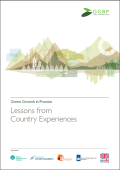Fast-growing cities in the East Asia and Pacific (EAP) region will define the region's energy future and its greenhouse gas (GHG) footprint. Rapid urbanization and growing standards of living offer a major opportunity to EAP cities to become the global engines of green growth by choosing energy efficient solutions to suit their infrastructure needs and by avoiding locking in energy-intensive infrastructure. The underlying studies in three EAP pilot cities show a clear correlation between investments in energy efficient solutions in all major infrastructure sectors and economic growth by improving energy and GHG emissions efficiency, cities not only help the global environment, but they also support local economic development through productivity gains, reduced pollution, and more efficient use of resources. This paper is organized as follows: part one focuses on urban energy use and GHG emissions in EAP; part two presents sustainable urban energy and emissions planning in three pilot cities; and part three gives sustainable urban energy and emissions planning guidebook: a guide for cities in EAP.
This report reviews in a systematic manner the skills available and skills required for the introduction and deployment of green technologies in the cement industry in Indonesia. It reviews the existing systems in place for developing a skilled labour force and proposes some specific recommendations on how to adapt to evolving demands. This report builds on continuing efforts made by the International Labour Organization in reviewing the need for skills for green jobs and the development of sector-based analysis for advancing global research work on promoting decent work. The report provides evidence and additional new information to support a tripartite dialogue on the best approach for promoting access to skills for green jobs and the greening of existing jobs in the Indonesian cement industry to create decent, productive work and to improve the environmental sustainability and competitiveness of the sector.

Green growth is becoming an attractive opportunity for countries around the world to achieve poverty reduction, environmental protection, resource efficiency and economic growth in an integrated way. Green growth strategies generate policies and programs that deliver these goals simultaneously. They accelerate investment in resource efficient technologies and new industries, while managing costs and risks to domestic taxpayers, businesses, communities and consumers.
This report carried out by the Green Growth Best Practice (GGBP) initiative, is the first comprehensive international assessment of lessons from experiences of pursuing green growth across all levels of government and all regions. The report is the result of a collaborative partnership between the Climate & Development Knowledge Network (CDKN), the European Climate Foundation (ECF) and the Global Green Growth Institute (GGGI). It engaged 75 authors in evaluating more than 60 programs around the world.
The green growth paradigm emerged from evolving global strategies that coherently promote a more socially inclusive, low-carbon, resource-efficient, stable economy, with decreasing poverty. Opportunities and challenges associated with the paradigm shift are expected to transform the travel and tourism (travelism) sector in all respects and on a global scale. This involves the transformation of the entire travelism value chain, as well as the communities in tourism destinations. However, there is a lack of systematic reports on wide-ranging and complex implications of the green growth paradigm for the travelism sector.
Developing countries are faced with the dual challenge of reducing poverty while improving management of natural capital and mitigating the emission of greenhouse gases (GHG) and local pollutants. The challenge is particularly acute for large, rapidly growing economies, such as India, China and Brazil. In 2007 the Energy Sector Management Program (ESMAP) and the World Bank began to provide support to countries to develop long-term frameworks for reducing GHG emissions in a way that is compatible with economic growth objectives. This report presents lessons learned from seven country studies. These include: countries must take the leading role; adopt a flexible approach and build a multi-disciplinary team; stakeholder engagement and consensus building is essential; allow sufficient time and resources; and invest in data and tools. The report is intended as a practical guide for government officials, practitioners and development agencies involved in low carbon development planning.
This summary was prepared by Eldis.
